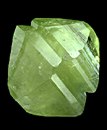|
|
| Formula: | NaAl3(PO4)2(OH)4 |  Click to see a larger image |
||
| Crystal: | Monoclinic | |||
| Hardness: | 5.5 | |||
| Spec. Gr.: | 2.98 | |||
| Streak: | Colorless | |||
| Cleavage: | Good | |||
| Location: | Córrego Frio Mine, Linopolis District, Minas Gerais, Brazil |
| Brazilianite, in small amounts, is found in numerous world localities, but only Brazil's state of Minas Gerais produced fine crystals. The Córrego Frio mine at Divino das Laranjeiras yielded the best gem crystals, and is the type locality. Brazilianite is named after its country of origin. Its typical colors are pale to deep greenish yellow, and it associates with beryl, tourmaline, zircon, garnet, tapiolite and a number of rare phosphates. The Córrego occurrence was discovered by Alfredo Severino da Silva in 1942. Prominent author, Frederick Pough helped identify Brazilianite, while gem-dealer Edward Swoboda, first systematically worked the Córrego deposit. Brazilianite generally occurs as single crystals in vugs. One of the largest known gem-quality crystals weighs nearly 1kg and is in the Smithsonian Institution. The nearly perfect 4.5-centimeter crystal in the UCSB Geology Collection is considered the world's best twin crystal of Brazilianite. |
|
Bibliography: Cassedanne, J.P., The Córrego Frio Mine. Mineralogical Record, V14, No. 4, pg. 227-237. Bancroft, Peter, World's Finest Minerals and Crystals, 1984, pg. 201-204. |
|
University of California, Santa Barbara—Department of Earth Science Copyright © 2005 Regents of the University of California Send your comments to the Web Page Editor |